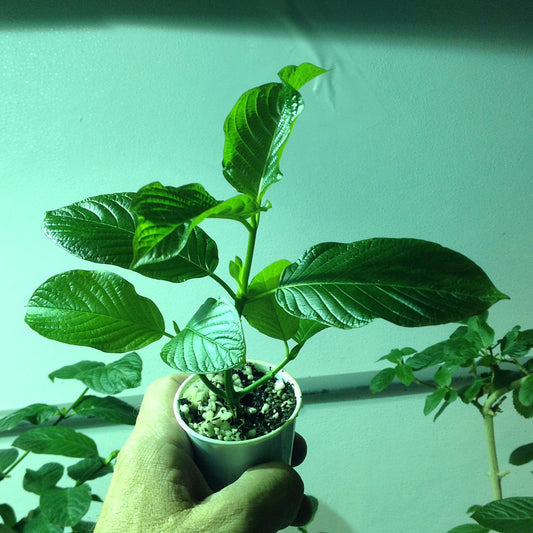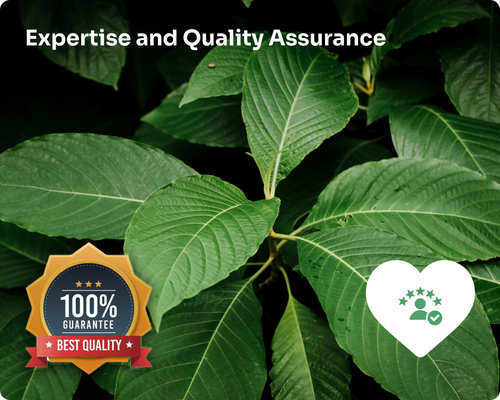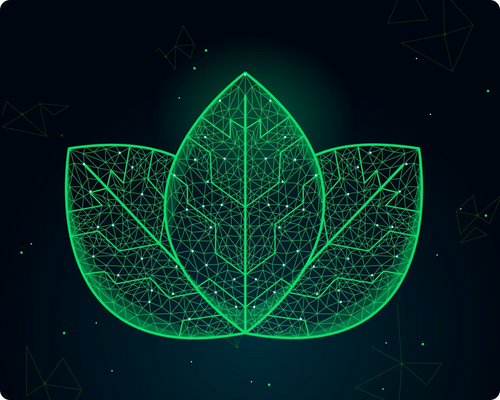The Mitragyna genus is a group of tropical trees with remarkable qualities. These plants have captured the attention of botanists, researchers, and traditional medicine practitioners due to their unique properties. Let's explore what makes these plants special and why they continue to interest scientists and enthusiasts around the world.
Key Points About Mitragyna speciosa
- Mitragyna speciosa is a tropical tree native to Southeast Asia, found in Thailand, Malaysia, and Indonesia
- It belongs to the coffee family (Rubiaceae), sharing some genetic similarities with coffee plants
- The tree contains over 40 natural compounds, including alkaloids like mitragynine and 7-hydroxymitragynine
- Mitragyna speciosa has a long history of traditional use in its native regions
- Scientific research on this plant is ongoing, exploring its unique properties and potential uses
- The leaves of Mitragyna speciosa can vary in color, including red, green, and white vein varieties
- How the plant is grown and harvested can greatly affect its alkaloid content
- Legal status varies around the world, with some countries restricting or regulating its use and distribution
1. Introduction to the Mitragyna Genus
Mitragyna trees are part of the coffee family and grow in tropical parts of Asia and Africa. These big trees have large, wide leaves and can grow up to 30 meters tall in nature. They can live in different tropical places, from rainforests to mountains. Different Mitragyna species have been used in various cultures for a long time. Each type of Mitragyna has its own special role in local customs. Scientists are very interested in these trees because they have many complex chemicals, especially alkaloids, which are special plant compounds.
2. Mitragyna Speciosa: The Most Well-Known Species
Mitragyna speciosa, often called Kratom, is the most famous Mitragyna tree. It grows naturally in Southeast Asian countries like Thailand, Malaysia, and Indonesia. People there have used it for a long time as part of their traditions. Recently, many people have become interested in this tree because of its unique properties. At Mitra Science, we offer many types of ethically sourced Mitragyna speciosa products for research and learning. We have different strains and forms of the plant so researchers can study it closely. Mitragyna speciosa has special leaves with big veins that can be red, green, or white. These color differences often mean the leaves have different types of alkaloids, which makes studying this plant very interesting for scientists who study plants and their chemicals.
3. Mitragyna Hirsuta: A Lesser-Known Relative
Mitragyna hirsuta, sometimes called Kra Thum Kok, is another interesting Mitragyna species. It grows naturally in parts of Southeast Asia, especially in Thailand and Vietnam. It has its own unique properties that make it different from Mitragyna speciosa. While not as well-known as Kratom, Mitragyna hirsuta is still an intriguing plant for people who like studying plants. Our Mitragyna hirsuta collection offers different forms of this plant for those interested in studying it. This species has large, oval leaves that feel a bit fuzzy. That's why it's called "hirsuta," which means "hairy" in Latin. Mitragyna hirsuta has different chemicals in it compared to Mitragyna speciosa, which makes it interesting for scientists to study and compare.
4. Mitragyna Javanica: The Javanese Mitragyna
Mitragyna javanica is a species native to Indonesia and Malaysia, especially common on the island of Java, which is why it's named that way. While it's similar to other Mitragyna plants, it has its own special features. People in its native regions have used this plant traditionally for various purposes, and now scientists around the world are getting interested in studying it. Mitragyna javanica is known for its large, shiny leaves and impressive tree-top, making it stand out in its natural habitat.
At Mitra Science, we provide high-quality Mitragyna javanica products for those who want to explore this unique species. Our products allow researchers and plant enthusiasts to study the plant's properties in different forms, from raw leaves to concentrated extracts. Mitragyna javanica has its own unique set of chemicals, even though it's similar in some ways to other Mitragyna species. This makes it exciting for scientists to study and compare with other plants in the Mitragyna family, possibly leading to new discoveries about how these fascinating plants evolved and became different from each other.
5. Mitragyna Parvifolia: The Indian Mitragyna
Mitragyna parvifolia is a species found mainly in the Indian subcontinent, particularly in parts of India, Sri Lanka, and Bangladesh. This tree has been an important part of traditional practices in India for a long time, where it's known by different local names like "Kaim" or "Kalam." Its unique properties make it interesting for plant researchers to study, especially in relation to traditional Indian medicine and how different cultures use plants. Mitragyna parvifolia has smaller leaves compared to other Mitragyna species, which is why its scientific name includes "parvifolia," meaning "small-leaved" in Latin.
While it's not as common in the global market, Mitragyna parvifolia adds a lot to the variety of the Mitragyna genus. It grows in a different part of the world from its Southeast Asian relatives, which gives scientists valuable information about how adaptable and diverse the Mitragyna genus is. Our Mitragyna parvifolia collection gives researchers the chance to study this less-known species and compare it to other Mitragyna plants. This species is particularly interesting because it might be useful in sustainable forestry and farming systems, as it grows fast and can thrive in many different soil conditions.
6. Botanical Characteristics: What Makes Each Species Unique
Each Mitragyna species has its own set of plant features that make it special. These differences show how they've adapted to different environments and evolved over time. You can see these differences in the shape and size of their leaves, how their flowers are structured, how they grow overall, and even in the tiny details of their cells when looked at under a microscope. For example, Mitragyna speciosa usually has large, oval-shaped leaves with big veins, while Mitragyna hirsuta leaves might be slightly different in shape or texture, often feeling a bit fuzzy.
These plant differences are important for correctly identifying and classifying Mitragyna species, especially because some of them look quite similar. They also contribute to the unique properties of each plant, affecting things like what chemicals they contain and how well they can adapt to different environments. At Mitra Science, we carefully source and identify our Mitragyna products to make sure they're accurate for research purposes. Our team of plant experts uses a combination of looking at the plants with the naked eye and under microscopes, as well as advanced chemical analysis, to verify the identity and purity of each species we offer. This careful approach ensures that researchers can confidently study the distinct characteristics of each Mitragyna species, helping to deepen our understanding of this fascinating group of plants.
7. Traditional Uses Across Cultures
Different Mitragyna species have been an important part of traditional practices in various cultures across Southeast Asia and the Indian subcontinent for hundreds, if not thousands, of years. These traditional uses cover a wide range of applications, from medicinal remedies to spiritual practices, showing how these plants have been used in different cultural contexts. For instance, workers in Thailand have traditionally used Mitragyna speciosa to help with tiredness and increase productivity, while Mitragyna parvifolia has played a role in traditional Indian medicine.
These traditional practices have sparked a lot of interest in scientific research. Scientists who study how different cultures use plants and those who study medicines are trying to understand why these plants have been used for so long. It's important to remember that while these traditional uses are interesting from a cultural and historical point of view, modern scientific study is needed to fully understand these plants and how they might be used today. Our blog post on Indonesian Kratom varieties explores some of the traditional ways Mitragyna speciosa has been used in Indonesia. This historical information helps researchers better understand why these plants are culturally important. Looking at how plants have been used traditionally is crucial for developing a complete understanding of Mitragyna species and their place in human culture and medicine.
8. Current Scientific Research and Potential Applications
The unique properties of Mitragyna species have attracted a lot of scientific interest recently, leading to more research across various fields. Researchers are carefully studying these plants to better understand their chemical makeup, how they affect living things, and how they might be used in fields like making medicines, treating illnesses, and creating new materials. At Mitra Science, we support this research by providing high-quality, ethically sourced Mitragyna products for scientific study, making sure researchers have access to reliable and consistent plant material for their investigations.
We are committed to quality and innovation in plant research, which is shown in our modern facilities and thorough testing procedures. We use advanced techniques like high-performance liquid chromatography (HPLC) and mass spectrometry to analyze the chemical profiles of different Mitragyna species and strains. This detailed analysis allows researchers to connect chemical composition with biological activity, paving the way for new discoveries and potential applications. We believe that ongoing scientific exploration of Mitragyna species could lead to exciting breakthroughs in various fields, from developing new medicines to finding innovative ways to use these plants in sustainable agriculture and environmental cleanup.
For more information on current research trends and potential future applications of Mitragyna species, check out our comprehensive blog post on future trends in natural supplements. This article talks about new areas of research and discusses how Mitragyna species might help address various challenges in health, agriculture, and environmental sustainability.
9. Quality Control and Sourcing Considerations
At Mitra Science, we think quality control and ethical sourcing for all our Mitragyna products are very important. This strong commitment ensures our products are pure, potent, and consistent for research purposes, setting a high standard in the industry. Our thorough testing procedures and dedication to being open about our processes are key parts of our operation, making us a trusted provider of high-quality plant materials for scientific research.
We have built strong partnerships with local communities in Southeast Asia to ensure sustainable harvesting practices and fair trade. This approach not only guarantees the high quality of our products but also supports the long-term sustainability of Mitragyna species in their natural habitats. Our sourcing practices involve carefully selecting mature plants, harvesting at the right times, and using environmentally friendly growing methods. We also have a comprehensive system that allows us to track each product from where it's grown to the final packaging, ensuring accountability at every step of the supply chain. This careful attention to sourcing and quality control is essential for maintaining the integrity of scientific research and building trust in the botanical research community.
10. Legal and Regulatory Considerations
The legal status of various Mitragyna species is very different across countries and regions, creating a complex situation that researchers and enthusiasts must navigate carefully. It's crucial for anyone working with these botanical products to be very aware of and strictly follow local regulations. At Mitra Science, we stay up-to-date with current regulations across different areas to ensure our products are distributed in full accordance with all applicable laws.
We strongly encourage all our customers to thoroughly familiarize themselves with the legal status of Mitragyna products in their specific area before making a purchase. This careful checking is essential not only for following the law but also for promoting responsible use and ethical research practices. The rules and regulations surrounding Mitragyna species are always changing, with ongoing debates and policy changes in many parts of the world. Because of this, we regularly update our policies and product offerings to reflect the latest legal developments. Using these plants responsibly and strictly following local laws are fundamental to ensuring the continued scientific study of these fascinating plants and maintaining the integrity of the research community.
Conclusion: The Fascinating World of Mitragyna
The Mitragyna genus offers a diverse and captivating array of species, each with its own unique properties and potential. From the well-known Mitragyna speciosa to lesser-known relatives like Mitragyna hirsuta and Mitragyna javanica, these plants continue to interest botanists, researchers, and enthusiasts alike. The rich history of traditional uses, combined with ongoing scientific investigations, shows that there's still much to be discovered and understood about these plants.
At Mitra Science, we're deeply committed to furthering the scientific understanding of Mitragyna species through our high-quality products and dedication to research. Our wide range of Mitragyna products, thorough quality control measures, and support for ethical research practices put us at the forefront of this exciting field. We invite you to explore our extensive range of Mitragyna products and join us in uncovering the vast potential of these remarkable plants. Whether you're an experienced researcher or a curious enthusiast, the world of Mitragyna offers endless opportunities for discovery and innovation.
Remember, while the world of Mitragyna is undeniably fascinating, it's very important to approach these plants with respect, caution, and scientific rigor. Always prioritize safety, legality, and scientific accuracy in your exploration of these botanical wonders. The future of Mitragyna research holds great promise, and with responsible study and ethical practices, we can continue to unlock the secrets of this extraordinary genus for the benefit of science and society.










